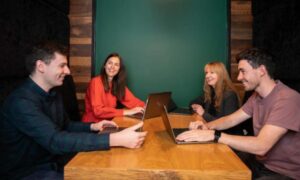Many businesses are adopting a wait-and-see approach when it comes to returning to the office. However, some are ahead of the curve and are taking proactive measures with their employees. We look at four that have taken bold steps towards the “new normal”.
Clunetech
In August 2020 Clunetech committed to a future of flexibility and provided its teams with certainty at a time that was anything but. Fast forward to the present, and feedback from its employees has shown that most people plan to adopt a hybrid working model going forward.
“Therefore we have made the decision to completely transform our HQ in Kilkenny from a standard office space to a hub that will foster collaboration and provide a space where entrepreneurship and technology innovation will thrive,” says Rachel O’Shea, head of employee experience at Clunetech.
“This is supported by a number of other initiatives internally such as our multi-platform approach to communications and engagement; our newly-implemented volunteer day that empowers employees to support the charities and causes close to their hearts; and our extensive L&D programme that ensures all employees are afforded the same learning opportunities regardless of where in the world they are.
“At Clunetech we appreciate that one size doesn’t fit all and what might suit one employee might not suit another. With this in mind employees have the control and freedom to determine what works best for them, and while renovations are ongoing our second Kilkenny office is open to those who wish to be on-site. To put it simply, the most important thing for us is that we provide our people with the best possible experience – whatever that looks like to them.”
Morgan McKinley
In Morgan McKinley Ireland its offices remained open throughout the pandemic, although its guidance was for everyone to work from home unless they could not work remotely.
“With most restrictions now lifted in Ireland we are welcoming all colleagues back to offices in a hybrid work pattern,” says Helen Gallagher, global head of HR at Morgan McKinley.
“In Cork we have opened a state of the art new office which was designed with an agile working model in mind. The timing of this new office opening was well aligned with the easing of restrictions, and is proving to be an excellent ‘post-pandemic’ workspace – with many wanting to come into the office every day.
“Our initial request at this stage is for people to come in one day a week to adjust to working in the office. We will transition to three days a week in the office from April onwards. Many are selecting to work more than three days in the office, which can be accommodated.
“In Cork we have moved to a fully agile ‘hot desk’ model but we also designed the layout of the office in a way that allows for people to have quiet time and space away from a group setting – having worked from home for almost two years a busy office can take a bit of adjustment.
“For some colleagues commuting will become a factor after a long break and with this in mind we have introduced increased flexibility so people can start anytime between 8am and 10am on their days in the office to avoid the worst of the traffic, bring the kids or school, do some exercise or bring the dog for an early morning walk before heading into the office. There is equal flexibility on finishing times.”
ORS
In 2018 ORS moved to a fully flexible working model with its team using their home as a base, with any of its five office locations open for them to use any time as they see fit.
“There is no grey area here – there is simply no expectation for any of our team to be in the office unless they themselves feel the need. Successful flexible working is about removing location as a barrier to employment, and we now have around 15 per cent of our team working between Ireland and other countries, depending on the time of year,” says John Brennan, managing director of ORS.
“For flexible working to work properly organisations need to create a culture in the business to support it. Creating this culture is extremely difficult, usually because of the deeply-held opinions and values of senior people in those organisations. There is a huge amount of research which shows that the main barrier to remote work in organisations is cultural.
“Flexible working is grounded in autonomy, which requires mutual trust between the employer and the employee. Presenteeism, or the belief that people work harder when they are seen, is still a huge issue within many businesses.
“We have found that both staff satisfaction levels and productivity have risen substantially since moving to this model. We have also found that this success is heavily linked to how we developed our guidelines and how trust levels were increased.
“We have no rigid remote work policy in ORS, simply because research shows that successful flexible working is much better suited to more informal arrangements and guidelines. Keeping things informal ultimately leads to our team feeling like their personal circumstances are accommodated more, and so they work harder to protect the arrangement.”
Laya Healthcare
In March 2020 Laya Healthcare saw a swift transition from 90 per cent of its team working onsite to 100 per cent home working, allowing a fully mobile-enabled workforce far quicker than anticipated pre-pandemic. This allowed it to leverage learnings and benefit from a remote working experiment on a scale which wouldn’t have occurred previously.
“Recognising the opportunity early on, we mobilised a strategic project team to turn our future working ambitions into a reality whilst also ensuring a seamless and safe return to the office,” says Brid Seymour, director of HR and team development at Laya Healthcare.
Communication and listening to employees was key, with the majority citing an interest in a blended working model.
“Our working model allows a choice of working either on a blended basis whereby team members may work remotely up to 80 per cent of the month, fully onsite or fully offsite, with our philosophy being that we are ‘remote friendly’ versus ‘remote first’.
“From the outset the aspiration for blended working has always been to exceed our teams’ expectations on flexibility whilst fostering an equitable, fair approach where career aspirations aren’t obstructed by chosen working preferences. It has been important to reinforce this principle by actively encouraging our management team to lead by example with their own working model choices,” she says
“In the coming weeks we will implement blended working in conjunction with our physical return to the office. Concepts such as hot-desking and ‘neighbourhoods’, use of collaborative technology and the redesign of meeting spaces will be conducive to a superior experience for our team whether onsite or offsite.”










